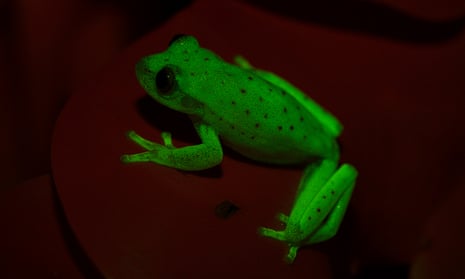The world’s first fluorescent frog has been discovered near Santa Fe in Argentina.
Scientists at the Bernardino Rivadavia Natural Sciences Museum in Buenos Aires made the discovery by accident while studying the pigment of polka-dot tree frogs, a species common across the continent.
In normal light the frog appears to have a dull, mottled browny-green skin with red dots, but under UV light it glows a bright fluorescent green.
Fluorescence – the ability to absorb light at short wavelengths and re-emit it at longer wavelengths – is uncommon in creatures that live on land.
The translucent frog was found to use a combination of lymph and glandular emissions to fluoresce.
The researchers, who published their discovery on 13 March in Proceedings of the National Academy of Sciences, found that the trait enhanced the brightness of the frog by 19-29% depending on the level of ambient light in its surroundings.
The compound causing the blue–green glow of the polka-dot tree frog was not previously thought to exist in vertebrates and its discovery has excited researchers.
“This is very different from fluorophores found in other vertebrates, which are usually proteins or polyenic chains,” Maria Gabriella Lagoria, a photochemist at the University of Buenos Aires and study co-author, told Chemistry World.
The discovery opens up the possibility that other amphibians may be able to fluoresce, particularly those with translucent skin similar to that of the tree frog.
Speaking to the journal Nature, which first published news of the fluorescent frog, co-author Julián Faivovich expressed his hope that the discovery would inspire interest in the phenomenon, saying he hoped scientists would “start carrying a UV flashlight to the field”.








